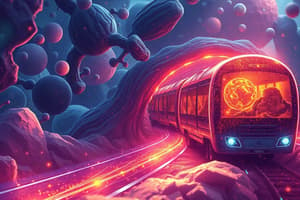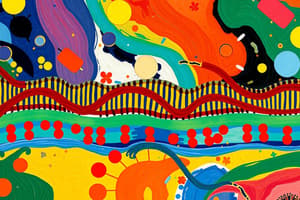Podcast
Questions and Answers
What process is likely occurring if you measure a high and gradually increasing concentration of a polar molecule inside a cell, while the ATP concentration inside the cell is dropping?
What process is likely occurring if you measure a high and gradually increasing concentration of a polar molecule inside a cell, while the ATP concentration inside the cell is dropping?
active transport
Energy used in cellular respiration can originate from:
Energy used in cellular respiration can originate from:
- carbohydrates
- proteins
- fats
- All of the above (correct)
The phosphate groups in ATP:
The phosphate groups in ATP:
- store energy.
- are negatively charged.
- are linked through the sugar molecule.
- All of the above are correct. (correct)
When ATP is hydrolyzed to ADP, what is removed?
When ATP is hydrolyzed to ADP, what is removed?
Which of the following is NOT a product of photosynthesis?
Which of the following is NOT a product of photosynthesis?
What color does a pigment appear if it reflects all wavelengths of visible light?
What color does a pigment appear if it reflects all wavelengths of visible light?
The object depicted in the figure is an animal cell.
The object depicted in the figure is an animal cell.
A plant whose leaves are reddish-yellow is NOT absorbing light from which wavelengths of the visible light spectrum?
A plant whose leaves are reddish-yellow is NOT absorbing light from which wavelengths of the visible light spectrum?
A green plant can carry out photosynthesis if given nothing more than:
A green plant can carry out photosynthesis if given nothing more than:
What do active transport processes usually require?
What do active transport processes usually require?
An inherited disease results from abnormal mitochondria passed from mother to child. What is the most likely symptom of this disease?
An inherited disease results from abnormal mitochondria passed from mother to child. What is the most likely symptom of this disease?
Which of the following pieces of evidence for the endosymbiotic theory of mitochondria is INCORRECT?
Which of the following pieces of evidence for the endosymbiotic theory of mitochondria is INCORRECT?
Every time energy is converted from one form to another, all of the energy is usefully converted.
Every time energy is converted from one form to another, all of the energy is usefully converted.
Define diffusion.
Define diffusion.
Sugar and CO2 are dissolved in water to make carbonated soft drinks. Which of the following is the solute?
Sugar and CO2 are dissolved in water to make carbonated soft drinks. Which of the following is the solute?
Oxygen gas produced during photosynthesis originates as:
Oxygen gas produced during photosynthesis originates as:
When is a cell's interior considered isotonic to the surrounding fluid?
When is a cell's interior considered isotonic to the surrounding fluid?
Which cellular structure enables a cell to differ structurally and biochemically from its surroundings?
Which cellular structure enables a cell to differ structurally and biochemically from its surroundings?
The movement of H+ into the stomach is accomplished through what?
The movement of H+ into the stomach is accomplished through what?
When a vase falls to the floor, what happens to the energy in the system?
When a vase falls to the floor, what happens to the energy in the system?
What is the net movement of molecules from locally concentrated regions to uniform distributions best described as?
What is the net movement of molecules from locally concentrated regions to uniform distributions best described as?
What are the two distinct "faces" of the phospholipids that make up the surface membrane of a cell?
What are the two distinct "faces" of the phospholipids that make up the surface membrane of a cell?
Where does glycolysis occur?
Where does glycolysis occur?
The most effective portion(s) of the visible spectrum in driving photosynthesis is (are):
The most effective portion(s) of the visible spectrum in driving photosynthesis is (are):
Under what conditions do fermentation reactions generally occur?
Under what conditions do fermentation reactions generally occur?
What does the first law of thermodynamics state?
What does the first law of thermodynamics state?
You are bored at a lunch meeting and surreptitiously place a raisin in your glass of water. The raisin swells to twice its original size. Relative to the water, the raisin must have been:
You are bored at a lunch meeting and surreptitiously place a raisin in your glass of water. The raisin swells to twice its original size. Relative to the water, the raisin must have been:
Anaerobic mammals exist.
Anaerobic mammals exist.
Which of the following is a cellular characteristic of ALL eukaryotes?
Which of the following is a cellular characteristic of ALL eukaryotes?
According to the theory of endosymbiosis, the origin of chloroplasts probably involved what?
According to the theory of endosymbiosis, the origin of chloroplasts probably involved what?
Flashcards
Active Transport
Active Transport
Movement of molecules from low to high concentration, requiring energy (ATP).
Cellular Respiration Fuel
Cellular Respiration Fuel
Carbohydrates, proteins, and fats can all be sources of energy for cellular respiration.
ATP Phosphate Groups
ATP Phosphate Groups
ATP's phosphate groups store energy, are negatively charged, and are linked by unstable bonds.
ATP Hydrolysis
ATP Hydrolysis
Signup and view all the flashcards
Not a Photosynthesis Product
Not a Photosynthesis Product
Signup and view all the flashcards
White Pigment
White Pigment
Signup and view all the flashcards
Cell type in figure
Cell type in figure
Signup and view all the flashcards
Color Reflection
Color Reflection
Signup and view all the flashcards
Photosynthesis Essentials
Photosynthesis Essentials
Signup and view all the flashcards
Energy and Active Transport
Energy and Active Transport
Signup and view all the flashcards
Mitochondrial Disease Symptoms
Mitochondrial Disease Symptoms
Signup and view all the flashcards
Mitochondria Independence
Mitochondria Independence
Signup and view all the flashcards
Energy Conversion Inefficiency
Energy Conversion Inefficiency
Signup and view all the flashcards
Diffusion Defined
Diffusion Defined
Signup and view all the flashcards
Solute in Soft Drinks
Solute in Soft Drinks
Signup and view all the flashcards
Origin of Photosynthetic Oxygen
Origin of Photosynthetic Oxygen
Signup and view all the flashcards
Isotonic Definition
Isotonic Definition
Signup and view all the flashcards
Plasma Membrane Function
Plasma Membrane Function
Signup and view all the flashcards
H+ Movement into Stomach
H+ Movement into Stomach
Signup and view all the flashcards
Vase Falling Energy
Vase Falling Energy
Signup and view all the flashcards
Net Movement of Molecules
Net Movement of Molecules
Signup and view all the flashcards
Two Faces of Phospholipids
Two Faces of Phospholipids
Signup and view all the flashcards
Where Glycolysis Occurs
Where Glycolysis Occurs
Signup and view all the flashcards
Effective Photosynthesis Spectrum
Effective Photosynthesis Spectrum
Signup and view all the flashcards
Fermentation Conditions
Fermentation Conditions
Signup and view all the flashcards
First Law of Thermodynamics
First Law of Thermodynamics
Signup and view all the flashcards
Raisin in Water
Raisin in Water
Signup and view all the flashcards
Anaerobic Mammals
Anaerobic Mammals
Signup and view all the flashcards
Eukaryotic Characteristic
Eukaryotic Characteristic
Signup and view all the flashcards
Chloroplast Origin
Chloroplast Origin
Signup and view all the flashcards
Study Notes
- The concentration of a polar molecule is high and gradually increasing inside a cell, while ATP concentration is dropping.
- Active transport would be the best hypothesis for the process occurring.
Energy Sources
- Energy used in cellular respiration can originate from carbohydrates, proteins, and fats.
ATP
- The phosphate groups in ATP store energy for cellular work, are negatively charged, and release energy when broken.
- When ATP is hydrolyzed to ADP, one phosphate is removed.
Photosynthesis
- Carbon dioxide is not a product of photosynthesis.
Pigments
- A pigment that reflects all wavelengths of visible light appears white.
Animal cell
- The object depicted in the figure is an animal cell.
Light Absorption
- A plant with reddish-yellow leaves is not absorbing red and yellow wavelengths of the visible light spectrum.
Photosynthesis Requirements
- A green plant can carry out photosynthesis with only water, light, and air.
Active Transport
- Active transport, moving molecules from low to high concentration areas across a membrane, requires energy.
Mitochondrial Diseases
- An inherited disease resulting from abnormal mitochondria passed from mother to child likely causes extreme muscle weakness.
Endosymbiosis Theory
- The incorrect piece of evidence for the endosymbiosis theory is that mitochondria can survive and reproduce independently when removed from the host cell.
Energy Conversion
- Every time energy is converted, some of it becomes heat, a less usable kinetic energy form.
Diffusion
- Diffusion is the net movement of particles from high to low concentration areas.
Solute
- When sugar and CO2 are dissolved in water to make carbonated soft drinks, the sugar and CO2 are the solutes.
Photosynthesis Origin
- Oxygen gas produced during photosynthesis originates from oxygen atoms in water molecules.
Isotonic Solutions
- A cell's interior is isotonic when solute concentrations are the same inside and outside the cell.
Plasma Membrane
- The plasma membrane allows a cell to differ structurally and biochemically from its surroundings.
H+ Movement
- The movement of H+ into the stomach occurs through active transport.
Energy Conversion Example
- When a vase falls, potential energy is converted into kinetic energy.
Diffusion Defined
- The net movement of molecules from concentrated regions to uniform distributions is diffusion.
Phospholipid Faces
- The two faces are hydrophilic and hydrophobic.
Glycolysis
- Glycolysis occurs in all cells.
Photosynthesis Spectrum
- The most effective portions of the visible spectrum in driving photosynthesis are blue and red light.
Fermentation
- Fermentation reactions generally occur under low oxygen concentrations.
Thermodynamics First Law
- Energy can be transformed but not created or destroyed in normal chemical reactions.
Tonicity
- If a raisin swells in water, it was hypertonic relative to the water.
Anaerobic Mammals
- Anaerobic mammals do not exist.
Eukaryotic Cells
- A nuclear membrane is a cellular characteristic of all eukaryotes.
Endosymbiosis and Chloroplasts
- The origin of chloroplasts likely involved the engulfing of small photosynthetic prokaryotes by larger cells.
Studying That Suits You
Use AI to generate personalized quizzes and flashcards to suit your learning preferences.




